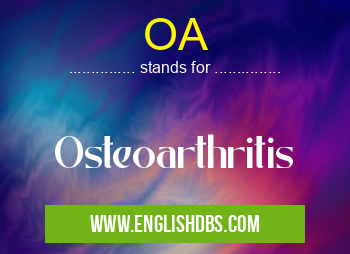What does OA mean in CLINICAL MEDICINE
Osteoarthritis (OA) is one of the most common forms of arthritis. It's a degenerative joint disease that is caused by wear and tear to the cartilage surrounding the joints. The resulting inflammation, pain, and stiffness can make it difficult to perform everyday activities. OA is also known as a degenerative joint disease and can occur in any joint in the body, but usually affects the knees, hips, lower back, hands and big toes. There are many lifestyle changes that can help manage the symptoms of OA.

OA meaning in Clinical Medicine in Medical
OA mostly used in an acronym Clinical Medicine in Category Medical that means Osteoarthritis
Shorthand: OA,
Full Form: Osteoarthritis
For more information of "Osteoarthritis", see the section below.
What does OA mean?
OA stands for Osteoarthritis, which is sometimes referred to as "degenerative joint disease". It is a chronic condition in which the protective cushioning between bones wears away leading to stiffness and pain in joints. The most commonly affected joints are knees, hips, fingers or wrists, lower back and big toes. Over time these joints may become even more painful to move due to swelling or inflammation in the area. As OA progresses it can cause bone spurs or calcium deposits around the edges of joints as well as deformity of certain parts of the body such as bony bumps on knuckles or bent fingers.
Essential Questions and Answers on Osteoarthritis in "MEDICAL»CLINICAL"
What is Osteoarthritis?
Osteoarthritis is a degenerative joint disease that causes pain and stiffness in the joints. It affects different joints in different people, but it most commonly affects the hips, knees, and hands. Over time, the condition can progress and cause damage to the surrounding bone and tissue, leading to deformities, disability, and decreased mobility.
Who is most at risk for developing Osteoarthritis?
Osteoarthritis is more common in older adults; however, younger adults may also develop the condition due to genetics or after some kind of injury or trauma. Other factors that may increase your risk of developing osteoarthritis include obesity, joint abnormalities, jobs or activities that involve repetitive motions or excessive stress on joints (such as certain sports), and prior joint injuries.
What are the symptoms of Osteoarthritis?
Common symptoms of osteoarthritis include pain or stiffness in affected joints when bending or moving them; swelling; decreased range of motion; creaking/cracking/popping sound when moving the joint(s); redness or warmth around affected area; bony lumps forming near affected area; and tenderness when applying pressure to affected area(s).
How is Osteoarthritis diagnosed?
Your doctor will likely perform an examination to evaluate your range of motion and check for any signs of swelling or tenderness near the affected joints. They may also order imaging tests such as X-rays or MRIs to get a better look at what’s happening inside your body. Blood tests may be necessary as well if other conditions (such as rheumatoid arthritis) need to be ruled out before making a diagnosis.
How can I manage my Osteoarthritis?
There are several ways you can help manage your osteoarthritis including lifestyle changes (eating a healthful diet, exercising regularly), taking medications to reduce inflammation/pain (e.g., nonsteroidal anti-inflammatory drugs), using hot/cold therapies, physical therapy/occupational therapy for strength training and improving flexibility/range of motion, using assistive devices such as walking sticks or braces for extra support when walking, and seeking alternative treatments such as acupuncture or chiropractic care.
What types of exercises are best for someone with Osteoarthritis?
While it varies from person to person depending on their individual case, people with osteoarthritis should focus on low-impact exercises like walking or cycling which will not put too much strain on their joint while still helping them remain active. Swimming is also a great option because it can provide resistance without putting too much stress on the body’s joints. Strength training through light weights is another beneficial exercise that will help strengthen muscles around affected areas while providing relief from symptoms like pain and stiffness.
Are there any foods that help reduce inflammation related to Osteoarthritis?
Eating a healthy diet that includes plenty of fruits, vegetables (especially those high in antioxidants such as berries), whole grains (e.g., oats), legumes (beans), fatty fish (e.g., salmon) rich in omega-3 fatty acids has been proven to reduce inflammation caused by osteoarthritis which can help alleviate some associated symptoms like pain and stiffness. Additionally boosts intake of essential vitamins like vitamin C which helps promote collagen production.
Is there anything else I should do besides taking medication for my Osteoarthritic pain?
In addition to medication prescribed by your doctor,making sure you're getting enough restorative sleep each night could make a big difference in reducing osteianthraitis pain over time. You should also consider engaging in relaxation techniques like meditation or yoga since these practices have been known help reduce stress levels which can lead improve overall wellbeing even in absence medical treatment.
Final Words:
Osteoarthritis (OA) is a very common form of arthritis that can cause pain and stiffness in your joints over time if left unmanaged. Fortunately there are various treatments available to help manage symptoms such as exercise regimens, medications and lifestyle changes that can all help improve daily function while managing discomfort associated with this condition. If you are experiencing symptoms related to OA talk to your healthcare provider about diagnosis and management options so you can get back on track with your day-to-day activities soon!
OA also stands for: |
|
| All stands for OA |
